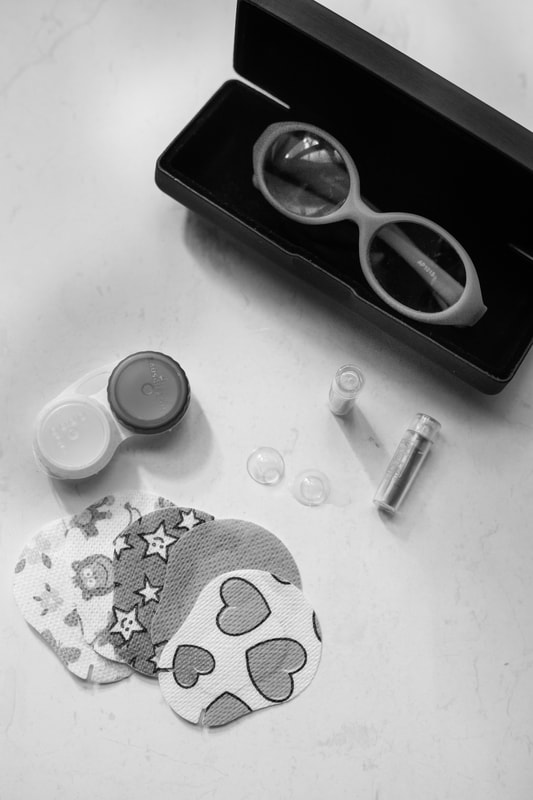Glossary of key terms
These terms are commonly used by health professionals and some are also used on internet support groups.
The Family Guide to Childhood Glaucoma and Cataracts by Levin and Fecarotta (available in a Kindle and paperback version) has a more detailed glossary.
The Family Guide to Childhood Glaucoma and Cataracts by Levin and Fecarotta (available in a Kindle and paperback version) has a more detailed glossary.
|
Amblyopia: reduced vision in one or both eyes because the brain and eye are not working well together. Also called 'lazy eye'
Aphakia: without a lens in the eye Atropine: an eye drop, which makes the pupil dilate (widen). It may be used either instead of patching (because it causes blurred vision), or at ophthalmology appointments to allow the doctor to see into the eye. There are sometimes side effects: see more information. BCC: bilaterial congenital cataract Bilateral: both eyes Cataract: a cloudiness or opacity of the lens of the eye Congenital: present from birth Contact lens: a thin plastic lens worn directly on the surface of the eye Cornea: the transparent front part of the eye Esotropia: a misalignment of the eyes, where one or both eyes turn inward; a type of strabismus EUA: examination under anaesthesia; conducted in hospital, so doctors can look closely at a child's eye while the child is asleep under anaesthetic Exotropia: a misalignment of the eyes, where one or both eyes turn outward; a form of strabismus Glaucoma: an eye disease that is usually the result of raised pressure inside the eye (the pressure of the eye is referred to as intraocular pressure or IOP). Glaucoma is diagnosed when there is damage to the nerve at the back of the eye called ''optic nerve cupping'. Severe optic nerve cupping will be associated with loss of visual field (peripheral or side vision). In children under 2 years of age glaucoma may cause the cornea (the clear window at the front of the eye) to become enlarged or cloudy. This can also interfere with vision and cause difficulty with wearing a contact lens. Intraocular lens (IOL): an artificial lens put in the eye during surgery Intraocular pressure (IOP): pressure inside the eye. Raised pressure is associated with glaucoma. 'Lazy eye': see amblyopia Lensectomy: removal of the lens of the eye by a surgical procedure Microphthalmia: literally 'small eyes'; one or both eyes may be affected Nystagmus: a condition in which the eyes make uncontrolled repetitive movements, eg. horizontal, vertical or circular shaking Occlusion, occlusion therapy: covering the eye with a patch to stimulate visual development in the uncovered eye Ophthalmologist: a medical doctor who has done additional training in the diagnosis and clinical and surgical management of disorders of the eye and visual system Optometrist: an eye health professional who can prescribe glasses and contact lenses, and a limited range of medications. Optometrists can diagnose and monitor eye disease. They do not do surgery, but will refer people directly to ophthalmologists if surgery or other complex treatment is needed. Orthoptist: an allied health professional who is trained to assess and treat patients with eye problems, especially eye movement problems such as strabismus and amblyopia. In some settings orthoptists may prescribe glasses and contact lenses. They do not do surgery. |
Patching: covering the eye with a patch to stimulate visual development in the uncovered eye; see also occlusion
Persistent fetal vasculature (PFV) also known as Persistent hyperplastic primary vitreous (PHPV): a congenital condition in which the jelly at the back of the eye (the vitreous) is hazy and scarred rather than clear; leading to blurred vision Posterior capsule opacification: cloudiness that may develop in the rear part of the lens capsule remaining after cataract surgery; sometimes described as secondary cataract Pseudophakic: where the natural lens has been replaced by an artificial ('pseudo') lens after cataract surgery Refractive error: a defect in the eye's ability to focus an image correctly; this results in blurred vision. Treated by glasses, contact lenses or surgery. Rigid gas permeable (RGP) lens (also known as a hard lens): contact lenses made of a firm, strong plastic that lets oxygen pass through Secondary cataract: see Posterior capsule opacification Secondary intraocular lens: an intraocular lens (IOL) that is inserted into the eye at some time after the original lens removal (lensectomy). This will avoid the need to wear a contact lens, but glasses may still be required to give the clearest vision. Strabismus: when one or both eyes does not line up correctly (see also esotropia, exotropia). This can be intermittent or constant. Unilateral: one eye. On some web-based peer support groups, a uni means a child with a cataract affecting one eye |
